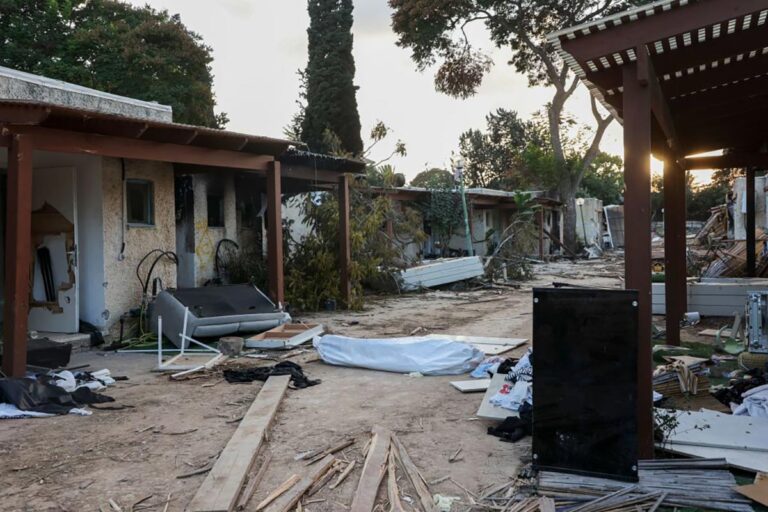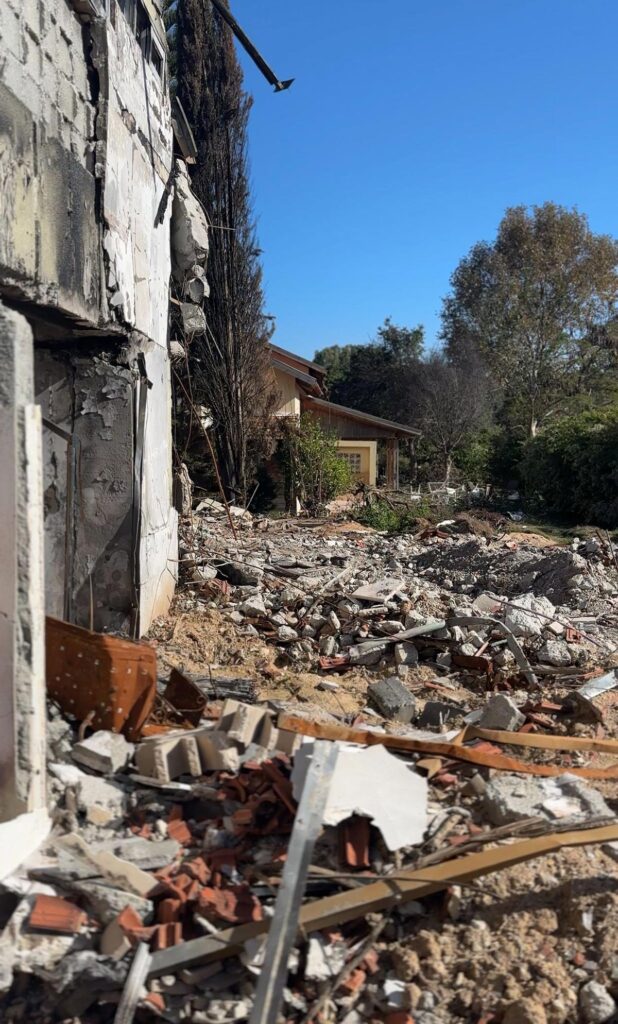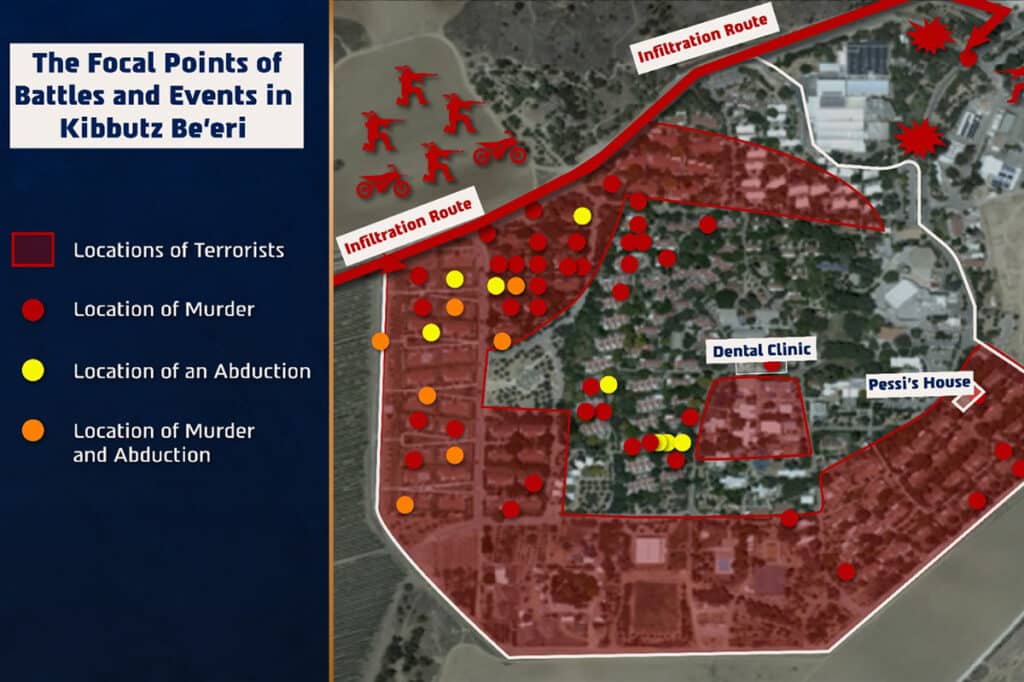
The IDF released the findings of its first investigation into the series of failures and complications that plagued the battle against Hamas in Kibbutz Be’eri, a town near the Gaza border, during the Oct. 7 massacre.
Be’eri was one of the towns hardest hit by Hamas terrorists. During the onslaught, 101 civilians and 31 security personnel were killed, 32 people were taken hostage, and over 125 homes were damaged or destroyed.
In the inquiry on Thursday, the IDF acknowledged that it had “failed in its mission to protect the residents of Be’eri.”
Let’s unpack why the battle at Kibbutz Be’eri ended so poorly and what the IDF hopes to gain from these investigations.
What happened in Be’eri on Oct. 7?

The fighting erupted just before 7 a.m. on Oct. 7 when Hamas terrorists infiltrated the kibbutz. For hours, residents and the local security team defended the town on their own. The first platoon of IDF soldiers arrived around 9 a.m. but quickly withdrew after suffering casualties.
Terrorists continued to infiltrate in the hours after. IDF soldiers only began entering the kibbutz again at 1:30 p.m., six hours after the attack began. During this period, the IDF described Be’eri as “occupied by the enemy.”
Fighting in the kibbutz continued for the next two days until the IDF cleared Be’eri entirely of Hamas.
Altogether, around 340 terrorists infiltrated the kibbutz throughout the attack.
The IDF stressed that it was not prepared for the extensive infiltration that took place on Oct. 7. It claimed that Israeli forces were only equipped for smaller-scale attacks with individual breaches, not one like the one Hamas carried out, which involved thousands of terrorists infiltrating along the entire border.
Israeli officials added that the military had difficulty creating a clear picture of what was happening in the kibbutz until hours after the attacks began, even though the Be’eri security team had established what was happening earlier that morning.
The investigation also found that the IDF struggled to organize and control the battle because of the terrorists’ spread throughout the kibbutz. This chaos led to a situation in which security forces gathered at the entrance of Be’eri instead of joining the fight inside.
In addition, there was no specific commander handling the battle until relatively late, which enhanced the chaos.

A hostage situation in the middle of a warzone
The report also covered the standoff between Israeli forces and Hamas terrorists holding civilians hostage at the home of local resident Pesi Cohen. The incident garnered media attention in the months following Oct. 7 because of concerns about the handling of the situation.
Amid the fighting, Hamas terrorists rounded up hostages in Cohen’s home. After shots were fired toward Israeli forces from the building, they surrounded it and launched a shoulder-mounted missile.
Once the forces realized hostages were held in the house, they began firing tank shells near and at the building to pressure the terrorists to surrender. During the exchange of fire, one tank shell bounced off the ground and struck near the doorway of the home, killing hostage Adi Dagan.
The hostage situation was further complicated because the fighting was ongoing in nearby homes and the terrorists in Cohen’s house were firing at Israeli forces too.
Eventually, security forces decided to enter Cohen’s home, resulting in a firefight with the remaining terrorists in the building. Only one hostage, Hadas Dagan, survived the battle.
It is unclear exactly how the other 13 hostages in the building died, although the IDF believes that most of them were murdered by Hamas.
Despite the tragic ending of the situation, the IDF stated that “under the complex and difficult circumstances, the commanders and forces made professional and responsible decisions, and fully exhausted negotiation efforts.”
Why does this matter?
The investigation into the failures in Be’eri was the first report on the events of Oct. 7 to be published by the IDF.
A series of additional investigations about other incidents throughout the massacre are set to be published in the coming months.
IDF Chief of Staff Herzi Halevi noted after the publication of the investigation that it “clearly illustrates the magnitude of the failure and the scale of the disaster that befell the residents of the south who defended their families with their bodies for many hours while the IDF was not there to protect them.”

These investigations are meant to provide some closure to the many families who lost their loved ones in the attack and lost their sense of security when the Israel-Hamas war began.
These inquiries will also be used by the IDF to fix the problems that led to the failures discussed in the report and improve the military’s ability to defend Israel in the future.
Residents of Be’eri welcome the investigation, but call for further action
The members of the kibbutz said that while the investigation helped them understand more about what happened on Oct. 7, they already deeply felt the failures that occurred during the massacre.
“We feel it in the loss of our 101 friends, loved ones, and family members, in our 11 friends who are still in Gaza, part of the 120 who must return home; We see this in the destruction of the kibbutz and in being refugees in our country for nine months,” said the members of the kibbutz.
They added that they felt that many questions were left unanswered in the report, including why security forces took so long to enter the kibbutz and how Hamas terrorists managed to breach the border fence without the IDF stopping them.
The kibbutz members also called for the establishment of a state commission of inquiry, an independent commission that has broad powers to investigate serious crises. Commissions like these were founded after the Yom Kippur War and after the assassination of Prime Minister Yitzhak Rabin.
Gadi Yarkoni – the head of the Eshkol Regional Council where Kibbutz Be’eri is located – added that kibbutz members believe that the IDF has not taken accountability for the failures of the mission: “the investigation presented continues the line that dominates Israel — no one is responsible. No one is to blame.”
“This is the biggest disaster in the country’s history, and all the political and military leadership is unmoved,” stressed Yarkoni, reiterating the demand for a state commission of inquiry.
